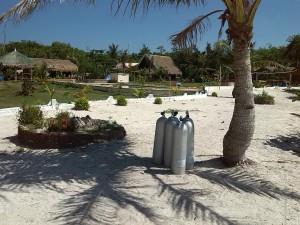
Diving Malapascua Island Cebu Philippines
I recently had the opportunity to take a working vacation to Malapascua Island. The island is located in the strait between the Island provinces of Cebu and Leyte in the Philippines. It is about a four and a half hours by bus or a two and a half hours by car trip from the Cebu International Airport. At the northern tip of Cebu you will find the town of Maya which provides ferry service to Malapascua which is about a 30 minutes boat ride away. The island is small, only about 1.6 km long and .6 km wide.
Most of the resorts are along a white sand beach at the southern tip of the island called Bounty Beach. Boats from Maya drop passengers at the west end of the beach. West and north of the beach is the area that is generally called the village. It is the largest of the nine little settlement around the island and the only one with paved roads. Most people walk to their destination but if you want a ride you can catch a motor scooter and back ride. The infrastructure is basic, some will even say primitive. Fresh water is limited as is electricity. There are no high rises or international hotel chains. It is a typical island fishing settlement. In the early 1990s, the island had a small tourism industry. It was mainly backpackers who stayed for the wonderful white sand beach, crystal clear waters and the genuinely friendly people. There were a handful of beach huts for rent. Back then Lonely Planet called it an undiscovered paradise. Dik de Boer a Dutchman and his Filipino wife read a Lonely Planet article and visited the island in 1996. They loved it and when they returned the following year they brought scuba gear and a portable compressor with them. Following tips from local fisherman they were soon diving with Thresher sharks, Hammerheads and Manta Rays.
In 1998, they open Exotic Dive Center the first dive center on the island. Today there is about a dozen small dive centers, and many small guest cottages. It is now estimated that the population of the island has doubled and 80% of the families are either directly or indirectly dependent on the diving industry.
The first question that you might consider is what so special about the island. The Philippines has over 7,000 islands most small and lightly inhabited. About a 20 minute boat ride from the island is a shoal that rises up from more that 200 meters to as close as 18 meters to the surface. Monad Shoal is about the same size as Malapascua island and has a number of cleaning stations on it. Cleaning stations that Thresher sharks love to visit. Monad Shoal is currently the only known location in the world where sighting are almost guaranteed. If fact, a few of the dive centers even offer a second dive if you do not get a close view of a Thresher shark. With an average sighting success of over 97% they seldom have to make good on the promise. In the early morning hours the Thresher dominate the shoal’s cleaners, however, the site is busy most of the time with rays, other species of sharks and other larger fish dropping by.
While the Thresher sharks are the headliners of the local diving, there is a great variety of other diving as well. There are currently over twenty dive sites in the area including ship wrecks and drift dive sites. Of the twenty sites over a dozen are within a few minutes of the island. There is diving available from training sites for those just learning to dive to those who are advanced divers. Gato island is a special two dive trip that most dive center make a few times a week. The area is a hour away and is known for its abundant corals and sponges as well as a great place to see sleeping white tip sharks and sea snakes. Advanced divers looking for something different will find it here as well. A tunnel runs under the island that advance divers can transverse. Back on Malapascua, Just off shore from the island’s lighthouse is the, well, the lighthouse reef. It is a shallow reef that is used as an open water training site by some dive centers. The beautiful coral gardens make for a wonderful relaxing dive. As wonderful the reef is for training, it is a very special sunset dive. The reef is the home of a vast number of Mandarinfish. Generally considered the most colorful of the reef fish they are also known for their exotic mating dances. Starting around twilight the males start their dances hoping to attract a female to dance with them.
Altogether the island is a very special place for diving. Unlike many other dive destinations the majority of the tourist are divers. Those who have been following this website may recall that a typhoon struck the Philippines late last year. This area was one of the areas hardest hit. The island has done well recovering, all the dive centers and resorts have reopened. It is business as usual. Well almost as usual. The peak season for the area is over and the number of visitors was well below normal. While always a great bargain for diving, the low season and quite possibly next season peak season will have many bargains to be had. If you are considering a trip to Asia for diving, look into doing some of the special diving that only Malapascua island can provide.